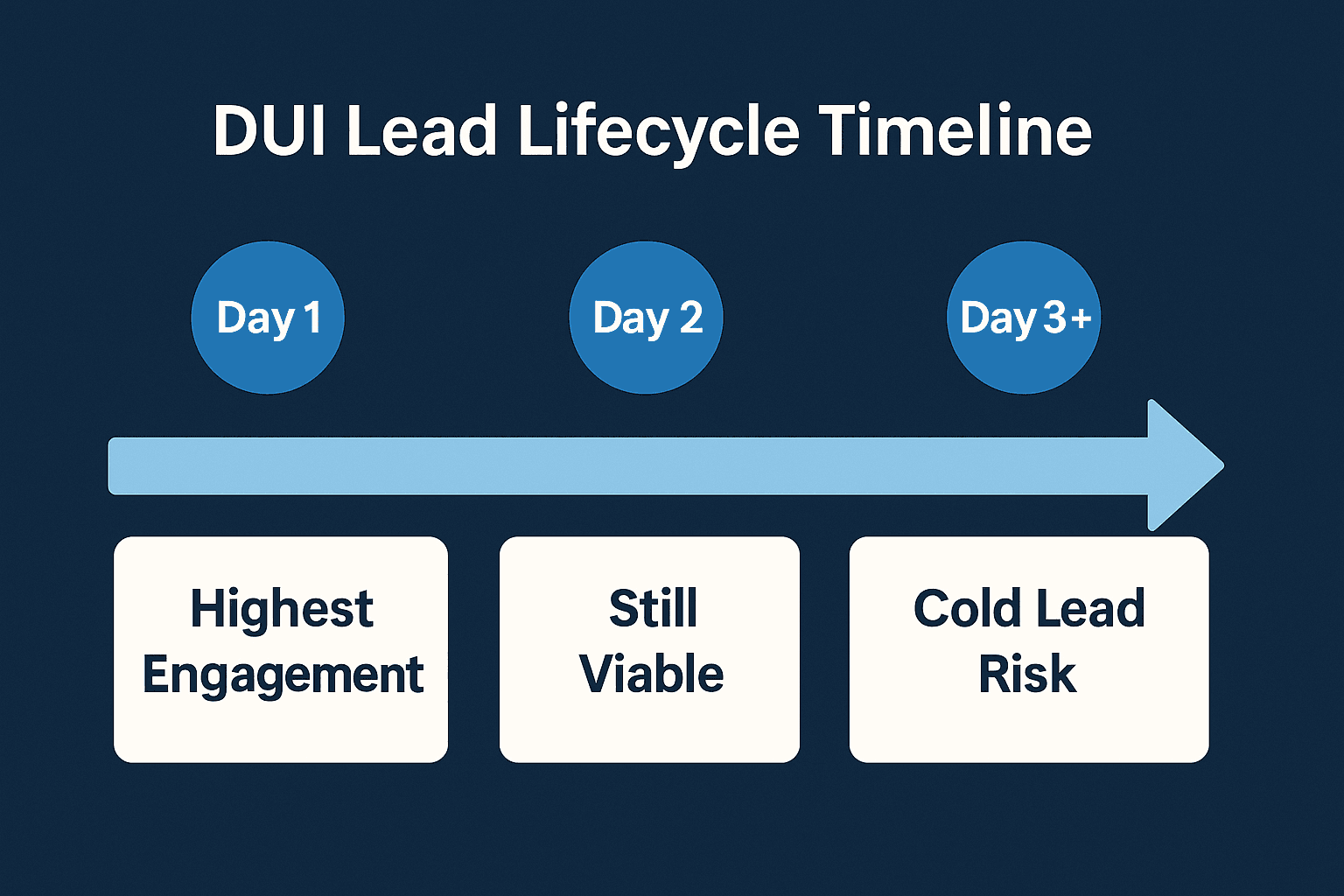DUI attorneys face a critical window of opportunity when it comes to converting leads. The difference between signing a high-value client and losing them to a competitor often comes down to timing your follow-up effectively. This guide will explore the best timeframes to act, why speed matters, and how LegalGrab helps you get there faster.
Understanding the right timing isn't just about being fast—it’s about being strategic. Using the right tools and data can dramatically increase your close rate, whether you're targeting Escambia County or broader Florida markets.
Why Follow-Up Timing Is Everything in DUI Lead Conversion
Most DUI leads begin their search for legal help within 24–48 hours of arrest. During this emotionally charged period, they’re actively seeking representation—dozens of other attorneys are trying to win their business.
- ⏱️ First 24 Hours: Highest engagement window
- 📉 48–72 Hours: Still active, but competition increases
- 📪 After 72 Hours: Response rates drop sharply
This makes it critical to integrate automated outreach and filtered lead data, such as the kind provided by LegalGrab’s Escambia DUI Lead Filters.
How LegalGrab Supports Fast, Targeted Outreach
LegalGrab arms attorneys with real-time arrest data to act before competitors do. By automatically syncing leads into your intake system, you can follow up via:
- 📬 Direct mail within hours of the arrest
- 📧 Email campaigns triggered instantly
- 📞 Timely phone calls based on court dates
This level of automation allows you to reach leads at the exact moment they’re most likely to convert.
The Role of Data in Follow-Up Timing
Reliable data should support timing decisions. For example, our analysis of Florida DUI patterns—outlined in the Florida DUI Hub—shows that weekday arrests tend to yield better next-day contact rates than weekend arrests.
Key Data Points That Inform Timing:
- 📅 Arrest date and time
- 🏛️ First court appearance schedule
- 📍 County-specific response patterns
These insights allow you to optimize when and how you reach potential clients.
Best Practices for DUI Lead Follow-Up
Simply contacting a lead quickly isn't enough—you need a follow-up sequence that builds trust and urgency. Here’s what high-performing attorneys do:
- ✅ Follow-up within 6–12 hours of arrest data being posted
- ✅ Use multi-channel outreach: email, mail, and calls
- ✅ Personalize every communication with name, arrest date, and county
- ✅ Include urgency-based language: “Act before your court date.”
County-Level Strategy: Escambia Example
Escambia County has seen a sharp increase in attorney conversion rates when follow-ups happen before arraignment. LegalGrab provides arrest-to-court timelines that allow attorneys to hit this sweet spot.
This type of court-date-driven timing is especially effective in rural counties where defendants have fewer legal options but receive the same volume of outreach.
Integrate Timing Into Your Firm’s Intake Workflow

Timing strategies only work if your intake team is equipped to execute. Automate wherever possible, and use LegalGrab’s integrations to reduce delays:
- 📥 Auto-import leads into your CRM
- ⚙️ Trigger pre-approved mailers or email campaigns
- 📊 Monitor engagement and tweak follow-up sequences
Final Thoughts: Get Ahead, Stay Ahead
In a crowded market, the firms that win are the ones that act fast and smart. DUI leads don’t stay leads for long, and timing could be your most significant edge. Use LegalGrab to automate timing, improve response rates, and convert more cases every month.
The Psychology Behind DUI Lead Responsiveness
After a DUI arrest, individuals are typically overwhelmed, embarrassed, and afraid. This psychological state creates a unique moment where an attorney's helpful, timely message can break through the noise. Your follow-up isn't just about offering services—it's about providing clarity during chaos.
The first few hours after an arrest are emotionally intense. If your outreach shows empathy, confidence, and a clear next step, you will earn the lead's trust more. Timing is important, but tone and timing together close the deal.
- 🧠 Stress response: Clients are more likely to act on fast, clear communication
- 💬 Clarity builds trust: Clear next steps reduce fear and increase engagement
- 🕒 Reassurance is time-sensitive: Delay causes doubt and makes leads go cold
FAQ: DUI Lead Follow-Up Timing
When is the best time to contact a DUI lead?
Ideally, you should make first contact within 6–12 hours of the arrest appearing in your system. That’s when the lead is most alert, motivated, and seeking answers.
What should I say in the first message?
Focus on empathy and clarity. Introduce your firm, mention the arrest context (without sounding aggressive), and provide one clear next step (e.g., “Call us for a free consultation before your court date on [date]”).
What if I missed the first 48 hours?
All is not lost. Focus your message on the urgency of court dates and legal deadlines. Leads may still respond if you create pressure around what happens if they don’t act in time.
Should I use phone, email, or mail?
Use all three. Multi-channel communication increases trust and brand recognition. Start with email and phone. Send direct mail as a follow-up reinforcement.
Take the Next Step with LegalGrab
Timing can make or break your case volume. Don’t leave it to chance. Let LegalGrab help you reach DUI leads with the speed, precision, and automation your firm needs to win more clients. From filtered lead targeting to court-based outreach strategies, we’ve built the tools to help you convert faster and smarter.




